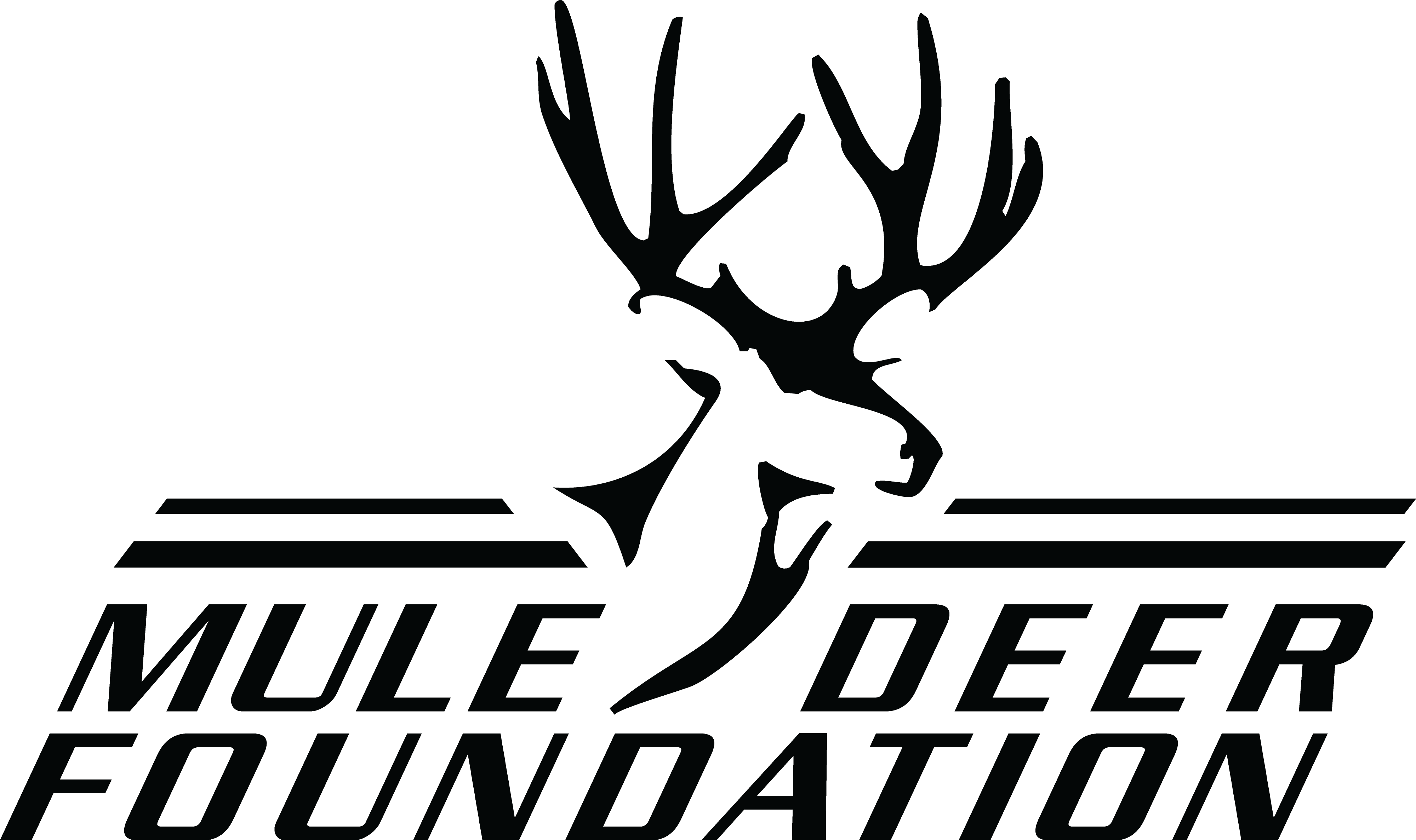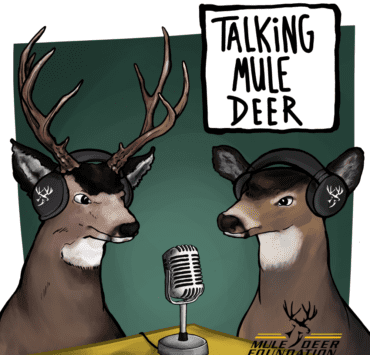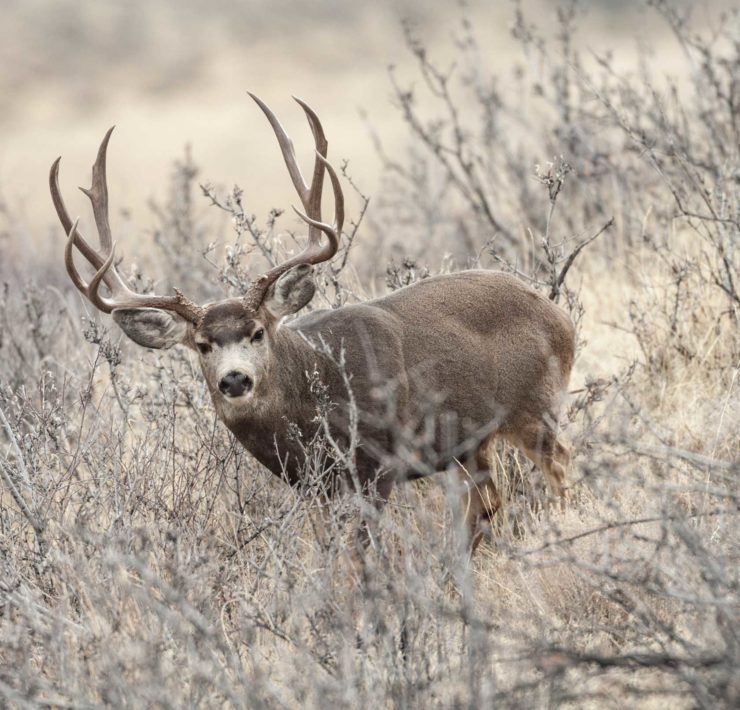Secretarial Order 3362 Impact on Migration Corridor Initiatives

The Mule Deer Foundation is the only conservation group in…
Grants Help Mule Deer Foundation’s Winter Range and Migration Corridor Initiative Take Flight
When former Secretary of the Interior Ryan Zinke signed Secretarial Order 3362, Improving Habitat Quality in Western Big Game Winter Range and Migration Corridors, during the Western Hunting & Conservation Expo in February 2018, it was a big leap forward for western big game and for the Mule Deer Foundation. The order, which continues to be supported by current DOI Secretary David Bernhardt, has been a gamechanger by focusing attention and directing new resources to habitat conservation in the migration corridors and winter ranges of mule deer, elk and pronghorn. The order has also allowed MDF to take a leadership role working with state, federal and non-profit conservation partners as we all work to implement S.O. 3362.
In late 2018, MDF’s efforts received a boost with a grant to build the organization’s capacity to help with a new Mule Deer Winter Range and Migration Corridor Initiative. Then in May, it was announced that MDF had secured a large grant for corridor and winter range habitat restoration projects in Wyoming. With the investment totaling over $1.1 million from these two grants, MDF’s Initiative is truly beginning to take flight.
Here’s an update on what’s been going on with S.O. 3362 and what MDF has been doing to help lead the charge.
Implementation of S.O. 3362
Since S.O. 3362, conservation partners have worked closely with the Department of the Interior and state fish and wildlife agencies to identify and prioritize conservation actions on corridors and winter range.
The first order of business was the appointment of a veteran U.S. Fish and Wildlife Service employee, Casey Stemler, to lead the DOI implementation efforts. Casey immediately met with the states and conservation partners and outlined what DOI will be doing and timeframes for completion. Casey appointed five DOI employees to act as regional liaisons to help the state fish and wildlife agencies. The state fish and game agencies were then asked to identify their 3-5 top priorities for migration, stop-over, and winter range habitats and 2-3 research priorities needed in identifying their priorities if information was lacking. All 11 states identified in the order responded to the request and, with the help of the regional liaisons, developed S.O. 3362 State Wildlife Action Plans which were approved in October 2018.
Based on the input from the Plans, a total of $3.2 million was provided to the states (each state received up to $300k) for research needs. Additionally, $2.75 million was provided by DOI agencies to the National Fish and Wildlife Foundation for habitat grants and $1.5 million was provided through the FWS Partners for Fish and Wildlife Program. In all, over $7.5 million was provided and funded to state agencies and conservation partners through direct efforts in implementing S.O. 3362 in Fiscal Year 2019 and research and habitat projects have begun.
In addition to research and habitat funding, four regional workshops were held in coordination with the Western Association of Fish and Wildlife Agencies Mule Deer Working Group and the Wyoming Migration Initiative to train agency personnel on the use of software which can identify migration routes from animal location data. Finally, a workshop was held on the needs for increased attention and funding for highway crossings and animal vehicle collisions.
Building Capacity
In late December 2018, MDF announced that it had received a $200,000 grant from the National Fish and Wildlife Foundation to increase the organization’s capacity to work on big game migration corridors and winter range projects. The 2-year grant will support MDF’s focused efforts to help implement corridor conservation and restoration projects focused in Colorado, Wyoming and Montana. Stewardship agreements and other partnerships will also help focus efforts in other states. The capacity grant allowed MDF to fully launch the Mule Deer Winter Range and Migration Corridor Initiative, a concept that Miles Moretti had developed shortly after the order was signed at Hunt Expo and has mentioned in his President’s Message in several MDF magazines.
“We appreciate the support of the National Fish and Wildlife Foundation so MDF can increase our capacity to help improve migration corridors and winter ranges that will benefit mule deer and many other species,” Moretti commented. “Since Secretarial Order 3362 was signed at our annual Western Hunting & Conservation Expo last February, MDF has been actively engaged in working with our state and federal partners to support big game migration conservation. With this grant, MDF will be able to move forward with our Migration Initiative and play a leadership role in implementing projects that will make a tangible difference on the ground.”
In spring 2019, MDF contracted with Steve Belinda to serve as a coordinator to manage the organization’s efforts for corridor and winter range conservation efforts. Belinda has nearly three decades of experience working with on-the-ground wildlife management and conservation policy in the West. He has worked for the BLM, Forest Service, Theodore Roosevelt Conservation Partnership, and most recently running an independent consulting firm, Beartooth Strategies, working on these issues. Through his consulting work he’s helped MDF on policy issues and conservation project planning for about 10 years. As the Migration Initiative Coordinator, Belinda will be dedicated to identifying and coordinating potential project opportunities as well as working with partners to ensure federal and state policy is aligned with the purpose of S.O. 3362.
“For a number of years, MDF has been working closely with our state and federal partners to support conservation of mule deer habitat through stewardship agreements and landscape restoration projects,” Belinda noted. “I’m excited to work with our excellent staff, volunteers and partners to be proactive in conservation efforts that will impact the most important winter range and corridors identified by the states through S.O. 3362.”
In addition to Belinda, MDF is increasing its communication and outreach efforts supporting the Migration Initiative and will be focusing regional staff time to implement priority habitat restoration projects.
Wyoming Projects
One of Belinda’s early priorities was to help secure funding for on-the-ground habitat restoration projects. The first big opportunity came through the National Fish and Wildlife Foundation’s (NFWF) Improving Habitat Quality in Western Big Game Winter Range and Migration Corridor Program. The majority of the funding for the grant program came through the BLM and FWS along with industry partner Conoco-Phillips and was coordinated by NFWF as part of the implementation of S.O 3362. Over $2.1 million worth of projects, with matching contributions of $8.6 million, were funded across six western states.
Through the program, MDF was granted more than $900,000 to work with the Wyoming Game and Fish Department (WGFD) on invasive plant management, land restoration and fence modifications to improve habitat for the Sublette and Platte Valley herd units. The NFWF grant funding will be matched by MDF and partners for a total estimated project impact of about $2 million.
“Using this grant funding and working with our partners at the Wyoming Game and Fish Department and landowners in the state, we will be able to remove invasive plant species on nearly 25,000 acres, do habitat restoration on nearly 2,000 acres of federal public land, and modify about 45 miles of fences to make them wildlife-friendly,” Moretti commented. “We are excited to launch these important habitat restoration and corridor improvement projects thanks to the grant from the National Fish and Wildlife Foundation.”
Wyoming’s Sublette and Platte Valley herd units have undergone extensive public review through the WGFD Mule Deer Initiative starting in 2010. Over the last eight years, projects in these herd units have accomplished hundreds of thousands of acres of invasive weeds treatments, dozens of miles of fence modifications, hundreds of thousands of acres protected through conservation easements, and tens of thousands of acres of habitat restoration through treatments such as prescribed burns, shrub plantings, conifer removal, and sagebrush treatments. This past success demonstrates the ability to complete projects and work with partners to implement proactive conservation efforts. The NFWF grant funding will continue this great work with new projects that focus on the removal of invasive plant species, land restoration including prescribed burns and removal of encroaching conifers, and fence improvements.
“Functional big game migration corridors are critical to healthy big game herds,” said Brian Nesvik, director of Wyoming Game and Fish. “For over a decade we’ve been working with the public, the Mule Deer Foundation and other important partners to put conservation on the ground as identified through our Mule Deer Initiative. It takes big money to tackle larger scale habitat projects and we are excited to work together to put these dollars on the ground to benefit wildlife.”
Moving forward
A lot has gone on since the signing of S.O. 3362 in February 2018. With new data in hand and increased focus by the states, federal agencies and partners, great things are starting to happen on the ground for western big game animals. MDF has been in the middle of these activities and the new funding will help to ensure that we can continue to play a leadership role.
Belinda concluded, “The NFWF grants will allow us to greatly expand our efforts in helping Wyoming Game and Fish improve important mule deer range in the state and we are looking forward to getting these projects up and running.”
Keep your eye out in this magazine for regular updates on MDF’s Mule Deer Winter Range and Migration Corridor Initiative.
The Mule Deer Foundation is the only conservation group in North America dedicated to restoring, improving and protecting mule deer and black-tailed deer and their habitat, with a focus on science and program efficiency. MDF is a strong voice for hunters in access, wildlife management and conservation policy issues. MDF acknowledges regulated hunting as a viable management component and is committed to recruitment and retention of youth into the shooting sports and conservation. Get involved in your state or become a member at www.muledeer.org or call 1-888-375-3337.




